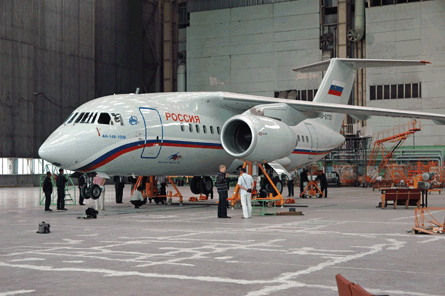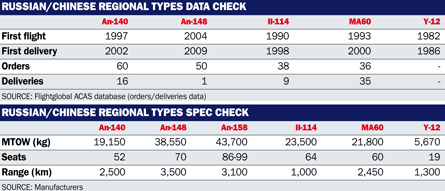The replacement of the increasingly aged Soviet regional airliners, particularly the Antonov An-24/26 and small Tupolev and Yakovlev jet aircraft, has been a slow and painful process.
Large numbers are still in service in Russia, Ukraine and former Soviet Republics, as well as in China, but attempts to produce modern types have been severely hampered by a lack of government funding and direction.
Additionally, there has merely been a trickle of orders for the new types in limited production, as well as those finally entering serial production, which would suggest that these do not measure up to the acquisition costs and operational standards that are demanded by the airlines.
Even attempts to access the export market by providing variants with Western engines and equipment have so far failed dismally. Plans by Russia's United Aircraft to reorganise the country's production plans in an effort to improve efficiency and aircraft output have also been slow in coming.
 |
|---|
© UAC |
Some stark figures illustrate this worrying situation. Since the 27-seat An-26 utility derivative An-38 first flew in 1994, only five have been delivered to customers. Not much better is the record of the 52-seat high-wing An-140, which first flew in September 1997 and was designed from the outset as a replacement for the venerable An-24.
Although produced in Russia, Ukraine, and Iran (as the IrAn 140), only 16 have been delivered to date. Four accidents, three of them fatal, have not helped. A recent repeat order from Yakutia and plans to relaunch a locally based airline in the Samara region with a batch of An-140s may revive interest expressed by other airlines in the past.
The passenger model is the An-140-100, but a 6t An-140T, a convertible An-140TK, and an executive An-140VIP are also planned, as are various utility derivatives.
The 64-seat Ilyushin Il-114, first flown in March 1990, has suffered funding problems, which has badly affected the production run. To date, only nine aircraft have been delivered, although earlier this year, UAC board chairman Alexei Fyodorov claimed it had orders for "almost 100 aircraft from Russian carriers alone", and that under its business plan, Tashkent Aircraft Production Enterprise "should produce 120-150 aircraft by 2015".
In addition to the TV7-117-powered base model, Ilyushin is strongly marketing the Il-114-100 with Pratt & Whitney Canada's PW127H turboprops and Western avionics.
As with all Russian aircraft, cargo and special missions variants are also offered. Still being promoted is the short-range, 52-seat Il-114-300, which has yet to fly. The Il-114-300 will be powered by the TV7-117SM engines and will have built-in airstairs and an auxiliary power unit to enable operations from poorly equipped airfields.
Development of the similar sized PT6A-powered MiG-110 was begun in 1995, but no progress has been reported, and only eight of the twin-boom 30-seat Sukhoi Su-80 STOL aircraft, whose development began as long ago as 1989, are believed to be in service. There have been suggestions that licence-production of the aircraft may be carried out in China, but this has not been confirmed.
CHINA'S POTENTIAL
China has had limited success with the Xian Y7, a licensed An-24 with locally built WJ5A turboprop engines, which later also became available with Pratt & Whitney engines as the Y7-200A. Only one of eight aircraft flying on China's routes is of regional size, with a distinct shortage of turboprop types, which would indicate a public preference for jet aircraft.
There is no doubt, however, that there is a large potential for both jets and turboprop aircraft, with AVIC of China forecasting a requirement for 1,282 regional aircraft in the 30- to 110-seat category over the next five years. Many of these will be turboprop-powered aircraft, particularly for thinner routes in the western parts of China, where there is the greatest potential.
The stretched 60-passenger MA60 (Modern Ark 60), based on the Y7-200A, was fitted with more efficient and higher-powered PW127J turboprop engines, a new Rockwell Collins Proline 2 avionics package and improved maintenance regime but, in spite of a competitive price and low operating costs, it has only achieved 18 civil customer deliveries since it first went into service with Sichuan Airlines in August 2000.
 |
|---|
The slow pace of sales, especially into the export market, was in large part due to an inability to build and maintain an adequate international support network. This is being addressed, and financial assistance from China for the purchase of aircraft, sometimes in exchange for rights to exploit natural resources, should see an upswing in export sales, though many would question the Chinese government's tactics.
Xian Aircraft Industries Group is also trying to achieve a better market presence at home and abroad with the improved MA600, which made its maiden flight on 9 October 2008 and is aimed for certification before the end of 2009.
Improvements to the aircraft include a lighter weight, enhanced cabin features and relocation of the passenger door towards the front, as well as upgraded Rockwell Collins Proline 21 avionics. A new, larger 70- to 80- seat MA700, which may be more suited to the length and density of the Chinese route structure, is on the drawing board and could replace the MA600.
In the smaller commuter category, the 19-passenger Harbin Y-12 high-wing twin turboprop has sold steadily since first flown in July 1982 and the aircraft is still in production. Total number of deliveries of more than 170 are claimed, of which 150 are for export. PT6A-27 engines, Western avionics and US Federal Aviation Administration certification of the Y-12 (IV) were the main contributors to this relative success.
The company is also working on a faster, pressurised Y-12F, which was due to fly in summer 2008, but has not been heard of since it was revealed at the Paris air show two years ago. The changes, which are said to comprise more powerful P&WC engines for increased speed, and a wider fuselage with bigger seats, improved aerodynamics and a retractable landing gear, are being made specifically to appeal to the aircraft's main export markets in Asia and the South Pacific.
ORDERS ON THE UP
Better prospects for commercial success in the regional market are offered by the 85-seat, Ukraine-designed Antonov An-148 regional twinjet, first flown in December 2004 and being built by Aviant in Kiev, Ukraine, and at the VASO plant in Voronezh, Russia.
The orderbook is growing, and the recent decision by the UAC to invest a further Rb5 billion ($160 million) in VASO, most of this sum allocated for An-148 production, should considerably enhance the aircraft's chances in the local market.
UAC also believes that there is potential for selling twice as many if the type receives international certification, and be fitted with Western engines.
The first commercial service with a prototype An-148 was operated by AeroSvit in June, and the first serially produced aircraft, delayed by supply chain problems, was handed over to St Petersburg-based Rossiya on the first day of October.
According to Ilyushin Finance, which holds the marketing rights for the aircraft, its portfolio comprises orders for 56 An-148s in various configurations, plus 54 options.
In September, Antonov revealed detailed information about its planned 99-seat An-158 derivative. Incorporating two fuselage plugs, the new variant will have a MTOW of 43,700kg (96,300lb), a maximum payload of 9.8t, cruise speed of up to 470kt (870km/h), and range of 3,100km (1,680nm).
Antonov also intends to produce two cargo models, the An-158T with a rear loading ramp, and the higher-payload An-158T-100 multipurpose aircraft, as well as the An-168 business jet.
TU-334 FUNDING PROBLEMS
It is now 10 years since the 102-seat Tupolev Tu-334 made its first flight and not a single example has entered service, as the programme has been mired in funding problems and selection of production facilities.
With an increased focus on the Sukhoi Superjet, the Tu-334 is now unlikely to ever enter serial production. In response to the impact of the global financial crises and weakening of demand, UAC announced in May a cut in the civil output of Russia's aircraft industry. Significantly, there is no production plan for the Tu-334 in the 2009-12 period.
Beriev is still promoting the 72-seat Be-210 passenger derivative of its swept-wing, T-tail twinjet amphibian aircraft, and its 27-seat, twin-turboprop Be-112 utility amphibian, but has not yet had any takers.
Source: Flight International























